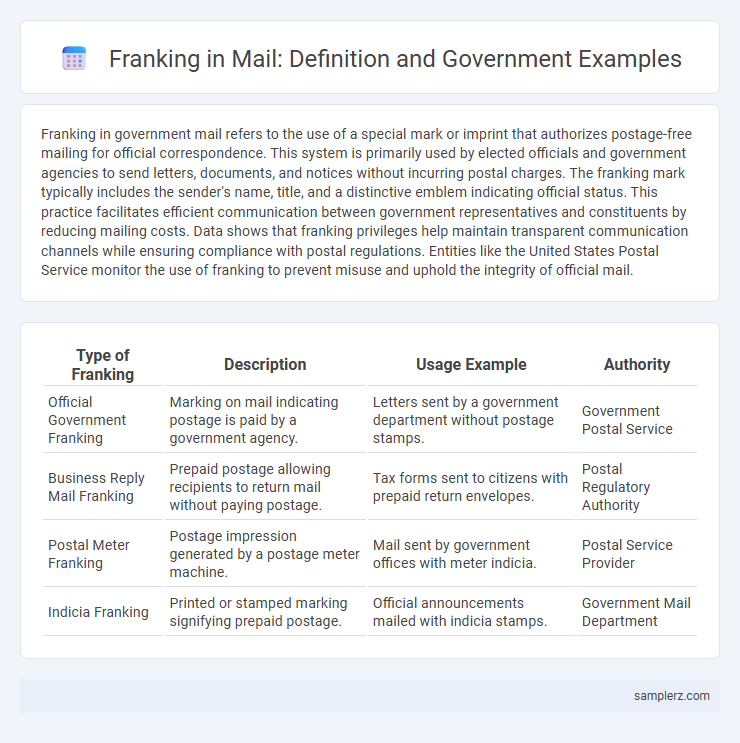Franking in government mail refers to the use of a special mark or imprint that authorizes postage-free mailing for official correspondence. This system is primarily used by elected officials and government agencies to send letters, documents, and notices without incurring postal charges. The franking mark typically includes the sender's name, title, and a distinctive emblem indicating official status. This practice facilitates efficient communication between government representatives and constituents by reducing mailing costs. Data shows that franking privileges help maintain transparent communication channels while ensuring compliance with postal regulations. Entities like the United States Postal Service monitor the use of franking to prevent misuse and uphold the integrity of official mail.
Table of Comparison
| Type of Franking | Description | Usage Example | Authority |
|---|---|---|---|
| Official Government Franking | Marking on mail indicating postage is paid by a government agency. | Letters sent by a government department without postage stamps. | Government Postal Service |
| Business Reply Mail Franking | Prepaid postage allowing recipients to return mail without paying postage. | Tax forms sent to citizens with prepaid return envelopes. | Postal Regulatory Authority |
| Postal Meter Franking | Postage impression generated by a postage meter machine. | Mail sent by government offices with meter indicia. | Postal Service Provider |
| Indicia Franking | Printed or stamped marking signifying prepaid postage. | Official announcements mailed with indicia stamps. | Government Mail Department |
Understanding Franking in Government Mail
Franking in government mail refers to the official marking or imprint that authorizes postage-free or reduced-rate mailing for government agencies and officials, ensuring secure and cost-effective communication. This system uses a unique frank that verifies the authenticity and prevents misuse of postal services, streamlining correspondence between government entities and the public. Understanding franking allows for efficient management of mailing costs while maintaining transparency and accountability in government communication.
Historical Evolution of Franking Privileges
Franking privileges originated during the American Revolution, allowing Continental Congress members to send mail without postage to facilitate rapid communication. The practice evolved throughout the 19th century as a symbol of official government correspondence, expanding to include members of Congress and federal officials. Modern franking systems utilize digital technologies to authenticate authorized mail, preserving historical intent while enhancing security and efficiency.
Types of Franking Used by Governments
Governments use various types of franking to manage official correspondence, including meter franking, permit imprint franking, and printed postage indicators. Meter franking stamps mail with a date and postage amount, allowing bulk mailing without individual stamps. Permit imprint franking enables large-scale government mailing by authorizing postage charges to a specific account, streamlining communication with citizens and agencies.
Official Government Franked Mail Examples
Official government franked mail typically includes correspondence from federal agencies such as the Social Security Administration or the Internal Revenue Service, which use prepaid postage permits to send tax notices and benefit statements. Congressional offices frequently utilize franking privileges to distribute newsletters and constituent information without direct postage costs. Military bases also rely on official franking to send deployment updates and official orders to service members and their families.
Regulations Governing Franked Mail
Regulations governing franked mail require strict adherence to authorized use by government officials to prevent misuse and fraud. Specific guidelines define eligible correspondence, mandate clear indication of official status, and impose penalties for violations to ensure accountability. Compliance with these regulations helps maintain transparency and proper allocation of public resources in government communications.
Benefits of Franking for Government Operations
Franking in government mail allows for cost savings by eliminating the need for individual postage stamps, streamlining bulk mailing processes and improving budget management. It enhances operational efficiency through faster processing and tracking of official correspondence, reducing administrative workload. The security features of franking machines ensure authenticity and prevent mail fraud, safeguarding sensitive government communications.
Security Features in Government Franked Mail
Government franked mail incorporates advanced security features such as unique barcodes, watermarked paper, and tamper-evident seals to prevent fraud and unauthorized use. These elements ensure the authenticity of postage paid by government agencies and facilitate accurate tracking of mail delivery. Enhanced encryption technologies embedded in the franked marking protect sensitive information during transit, maintaining confidentiality and integrity in official correspondence.
Comparing Franking Across Different Countries
Franking methods vary significantly across countries, with the United Kingdom using postage meters that print indicia directly on envelopes, while the United States relies on both meter stamps and digital postage printed via authorized software. In Australia, the use of Official franking machines ensures secure prepayment of postage for government correspondence, contrasting with Canada's reliance on Permit Mail systems for bulk mailing by public institutions. These differences reflect diverse postal regulations and government mail management strategies tailored to optimize efficiency and cost across national postal services.
Challenges and Misuse of Government Franking
Government franking, which allows officials to send mail without postage, faces challenges such as the misuse of this privilege for personal political campaigns or excessive mailings that strain public resources. Instances of franking abuse lead to increased taxpayer costs and undermine public trust in government transparency. Strict regulations and audits are essential to prevent fraud and ensure the system serves its intended official communication purpose.
The Future of Franking in Government Correspondence
The future of franking in government correspondence is moving towards digital postage solutions that enhance efficiency and reduce costs. Innovations such as electronic franking machines and cloud-based platforms enable secure, trackable mail processing while minimizing environmental impact. These advancements support faster communication between government agencies and citizens, promoting transparency and responsiveness in public service.

example of franking in mail Infographic
 samplerz.com
samplerz.com